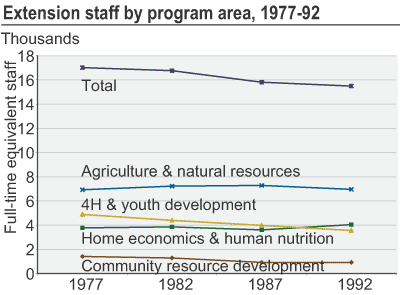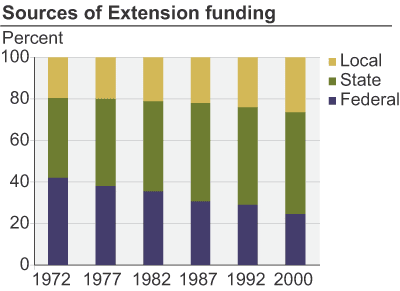Trends in Extension Resources
- by Mary Ahearn
- 4/1/2003
Communities, businesses, and individuals alike benefit from the programs, services, and projects provided by the Cooperative Extension Service. Its four programs—agriculture and natural resources, 4-H and youth development, home economics and human nutrition, and community resource development—disseminate various types of information and tools that the general public can apply in daily life. The agriculture and natural resources program, for example, advises farmers on agricultural production techniques, contracting, and a host of other topics through classes, web sites, or one-on-one consultation.
With a third of the U.S. population employed in farming at the inception of the Service in 1914, its largest program—in terms of funding and staffing resources—was agriculture and natural resources. Even now, agriculture and natural resources remains the Service's largest program area, though farming currently accounts for only 1 percent of U.S. employment.
A cooperative effort of Federal, State, and local governments, the Extension Service receives funds from all three sources. Over time, the proportion of funding from each source has shifted to rely more on State and local funding. States accounted for about half of total funding in 2000. The Federal share declined from 42 percent in 1972 to 24 percent in 2000.
Changes in staffing resources have been more subtle than changes in funding sources. ERS researchers recently examined administrative records on full-time equivalent (FTE) staff at the State level to gain a more precise understanding of these changes over the past quarter-century. Extension personnel declined by 2,100 positions, about 12 percent, overall between 1977 and 1997, with the greatest changes occurring between 1982 and 1987. In 1992, the most recent year for which program area data are available, nearly half of the Extension staff were allocated to the agriculture and natural resources program. From 1977 to 1992, as total staff declined, the staff dedicated to agriculture and natural resources increased slightly—less than 1 percent (30 FTEs)—while the staff dedicated to home economics and nutrition increased by 7 percent (253 FTEs).
Much of the information disseminated through the agriculture and natural resources program benefits farmers individually and is available in alternative forms in the private marketplace. Proponents of the Extension Service argue, however, that public investment in private, individual decisions benefits society as a whole because the resulting decisions translate into a more efficient agricultural system with lower food costs and more benign environmental impacts.
This article is drawn from:
- Agricultural Research and Productivity. (n.d.). U.S. Department of Agriculture, Economic Research Service.



